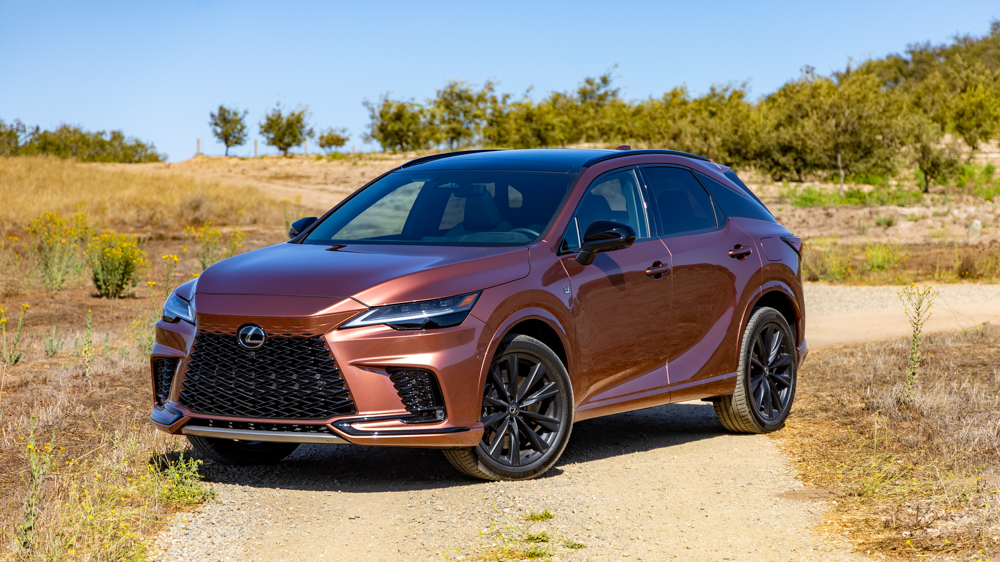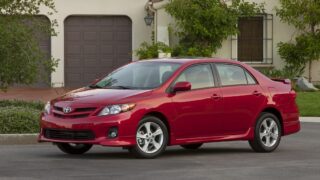F-Sport UN-Performance: How Lexus DIRECT4 eAxles Undermine Sportiness

In concept, the modular Lexus DIRECT4 eAxle is brilliant; in execution, it lacks the power to deliver a truly sporty driving experience.
Performance vehicle recipes used to be simple. Drop a hi-po motor into a sports car, SUV, or sedan; upgrade the handling, brakes, seats, and style; and brand your efforts with a special letter marque. BMW M, Mercedes AMG, Audi RS, and Lexus F come to mind. But with rising emissions regulations stifling naturally aspirated V8s, the auto industry has looked to alternative technologies like turbochargers and hybrid drivetrains to bring sporty and fun driving to model lineups. Case in point, the RX 500h and TX 500h F Sport Performance branded SUVs, which are mild family haulers with upgraded power, handling, and Lexus DIRECT4 eAxles.
An effort I applaud wholeheartedly from a brand that prioritizes and markets its driving signature.
The problem, sadly, is that, while the RX and TX 500h are both lovely crossovers, they fail as performance SUVs, benchmarks Lexus set out to both achieve and advertise. Why? Because these 500h models suffer from a fundamental power delivery design flaw. And at the heart of this flaw? We find one interesting but underpowered piece of technology: the much-touted Lexus DIRECT4 eAxle. But before we explore the eAxle, we need —
A Little F’n History

Named after the iconic Fuji Speedway, Lexus debuted the F marque in 2007 with the IS F sedan. Here, Lexus put a high-revving 400 horsepower 5.0L V8 in a compact sedan alongside better brakes, handling, seats, and design. With vehicles like the LFA, RC F, GS F, Lexus built up a full stable of F marque models bread to split time between the track and daily commutes.
Building on its new performance branding effort, Lexus also unveiled F Sport models, which historically add enhanced styling, seating, and suspension elements to otherwise stock drivetrains. (It’s a little more complex today, as Lexus now offers both F Sport Appearance and F Sport Handling packages, but the idea is pretty much the same.)
Lexus added a new F’n category in 2021 with the F Sport Performance moniker that sits halfway between a true F and an F Sport model. More power with upgraded brakes, handling, visuals, and seating, but not fully track-ready. The first model was the IS 500, which is essentially an updated version of the IS F — a rear-wheel drive, V8-powered compact sedan with all the goodies from the IS 350 F Sport.
Enter the 500h & Lexus DIRECT4 eAxle

Lexus redesigned its most popular model, the RX or Radiant Crossover, for the 2023 model year with its very own F Sport Performance model, dubbed the RX 500h, which is also a hybrid. For 2024, the three-row Lexus TX 500h F Sport Performance joined the growing lineup.
So what is a 500h F Sport Performance and how does it work?
The RX and TX 350 are FWD (front-wheel-drive) architecture SUVs powered by 2.4L turbocharged 4-cylinder engines that make 275 peak horsepower and 317 lb.-ft. of peak torque. In addition to the standard FWD setup, customers can also opt for AWD (all-wheel-drive) which uses a physical driveshaft and rear axle to deliver power to the rear wheels.
What do YOU think about these F Sport Performance SUVs?
Let us know HERE in the forums!
In the RX and TX 500h, Lexus engineers replace the mechanical AWD system with the standalone Lexus DIRECT4 eAxle (electronic axle). It’s essentially an axle with an electric motor tucked in the middle to drive the wheels, adding 91 extra ponies and 89 ft.-lbs of torque. This brings total system power to 366 peak horsepower at 6,000 rpm and 406 lb.-ft. of peak torque at 2,000 rpm. In the TX, that’s good for It can be programmed to deliver power and torque in many different ways to enhance acceleration, handling, and even stability control.
That’s good enough to drop the RX 500h’s 0-60 time to a MotorTrend-tested 5.9 seconds (compared to the RX 350’s 7.4 seconds). In a family crossover SUV that also offers more aggressive brakes, an adaptive suspension with multiple firmness settings, Lexus F Sport heated and ventilated front seats with improved bolstering, sleeker blacked-out trim moldings and wheels, and slightly improved fuel economy compared to the standard turbo motor.
So what’s the problem?
F-Sport UN-Performance

Frankly, from a driver’s perspective, the RX 500h and TX 500h are a mess, dynamically, because the way they deliver power is underwhelming.
To be fair, compared to most Lexus crossovers, the 500h models are a hoot. But drive them next to German performance SUVs, or even the IS 500, and several key flaws stand out. The RX and TX feel unsettled when tossed hard into corners. The adaptive suspensions feels too floppy at times; too jittery at others. And, during any hard acceleration, there’s no sense of authoritative shove or engaging engine sounds.
In short, slide in behind the wheel of an IS 500 or an Audi SQ5, and you’re in for an all-caps EXPERIENCE. Those vehicles love being tossed into corners, slap a smile on your face with every planted accelerator pedal, and deliver engine noises that either roar and scream or pop and burble. The IS 500 hits 60mph in 4.3 seconds and the SQ5 in 4.7
The problem with the 500h models, as best as I can tell, comes down to —
A Front-Wheel-Drive Power Imbalance (& Weight)

Naturally, there have been several terrific FWD vehicles over the years that drive well (the Civic Type R is well-regarded, for example). But the very best performance vehicles are much more likely to be rear-wheel or all-wheel-drive. The reason for this? When a vehicle accelerates hard, weight shifts back over the rear wheels, providing added traction and more thrilling acceleration. AWD/4WD vehicles are even better at quick acceleration because weight rests over all four driving wheels demanding traction.
But it’s important to note that performance AWD vehicles typically split the power evenly between the front and rear wheels.
However, the RX and TX 500h don’t split power 50/50. It’s more like 66/34 front bias because the DIRECT4 eAxle is limited to 91 horsepower. So when you launch from a dig, or try to accelerate out of a corner, the front wheels aren’t able to maximize grip and traction. Coupled with the added weight of the battery back and eAxle itself, the TX and RX 500h feel timid and numb for an SUV with these power specifications.
The same can be said for the all-electric RZ 450e, which also similarly utilizes a Lexus DIRECT4 eAxle. To be fair, the RZ isn’t supposed to be sporty. But it’s technically the quickest Lexus crossover, and most AWD EVs balance power front-to-back, making them more exciting to drive.
Even in the Toyota or Lexus family, look at the power balance on everything from the LC and IS 500 to the GX 550 and the GR Supra, GR Corolla, Tundra, Tacoma, and Sequoia. All wildly different vehicles that either have rear-wheel-drive or the ability to split power 50/50 between the front and rear wheels.
So What Now?

I’m not smart enough to be an engineer, but if Lexus truly wants to make an SUV worthy of the F Sport Performance moniker, it needs a genuine 50/50 power balance. To do this, I have two completely obvious ideas to suggest.
First, could they add more power to the Lexus DIRECT4 eAxle? The idea of a modular electronic axle is fascinating. And if you can balance out the rear drive system with the front, you have the makings for a more dynamic driving experience. But what if the better idea is one they already offer elsewhere in their crossover lineup?
The plug-in hybrid.
In the NX, the top model is the 450h+ plug-in hybrid, a system that pairs a naturally aspirated motor with two electronic motors (front and back). It can also be ordered with an F Sport Handling package, therefore combining several great features:
- All-electric driving for up to 37 miles
- 11 extra mpg compared to the turbo engine
- the quickest acceleration
- the best seating, suspension, and design elements of the lineup
To be fair, plug-in hybrids are also the most expensive and heaviest of the lineup. And they don’t appear to split front-to-rear power 50/50 either. But I would argue that the NX 450h+ is as fun to drive as, and a touch smoother than, the RX and TX 500h. Because that’s what Lexus promised with its latest F Sport Performance models. Fun and sportiness in an SUV that can compete with the Audi SQ5s of the world. But, while they’re still pretty good SUVs, and while most people will find them sporty, we know Lexus engineers can do better.
And I hope they do.
What do YOU think about these F Sport Performance SUVs?
Let us know HERE in the forums!
Photographs by Michael S. Palmer




